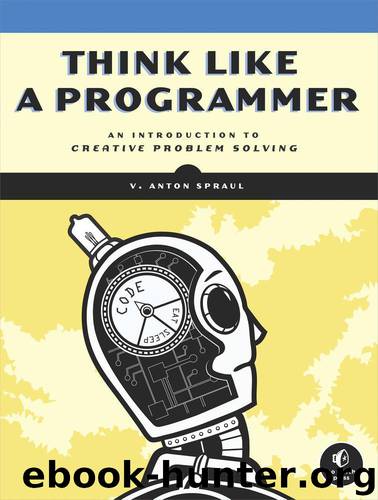Think Like a Programmer by V. Anton Spraul

Author:V. Anton Spraul
Language: eng
Format: mobi, epub
Tags: COMPUTERS / Programming / General
Publisher: No Starch Press
Published: 2012-08-09T16:00:00+00:00
Support Methods
A support method is a method in a class that does not merely retrieve or store data. Some programmers may refer to these as helper methods, auxiliary methods, or something else, but whatever they are called, they are what take a class beyond the basic class framework. A well-designed set of support methods is often what makes a class truly useful.
To determine possible support methods, consider how the class will be used. Are there common activities we would expect client code to perform on our class’s data? In this case, we’re told that the program for which we are initially designing our class will display students’ grades not only as numerical scores but also as letters. So let’s create a support method that returns a student’s grade as a letter. First, we’ll add the method declaration to the public section of our class declaration.
string letterGrade();
Now we need to implement this method. The function will convert the numerical value stored in _grade to the appropriate string based on the grade table shown in the problem. We could accomplish this with a series of if statements, but is there a cleaner, more elegant way? If you just thought, “Hey, this sounds a lot like how we converted incomes into business license categories back in Chapter 3,” congratulations — you’ve spotted an apt programming analogy. We can adapt that code, with parallel const arrays to store the letter grades and the lowest numerical scores associated with those grades, to convert the numerical score with a loop.
string studentRecord::letterGrade() { const int NUMBER_CATEGORIES = 11; const string GRADE_LETTER[] = {"F", "D", "D+", "C-", "C", "C+", "B-", "B", "B+", "A-", "A"}; const int LOWEST_GRADE_SCORE[] = {0, 60, 67, 70, 73, 77, 80, 83, 87, 90, 93}; int category = 0; while (category < NUMBER_CATEGORIES && LOWEST_GRADE_SCORE[category] <= _grade) category++; return GRADE_LETTER[category - 1]; }
This method is a direct adaptation of the function from Chapter 3, so there’s nothing new to explain about how the code works. However, its adaptation for a class method does introduce some design decisions. The first thing to note is that we have not created a new data member to store the letter grade but instead to compute the appropriate letter grade on the fly for every request. The alternative approach would be to have a _letterGrade data member and rewrite the setGrade method to update _letterGrade alongside _grade. Then this letterGrade method would become a simple get method, returning the value of the already-computed data member.
The issue with this approach is data redundancy, a term describing a situation in which data is stored that is either a literal duplicate of other data or can be directly determined from other data. This issue is most commonly seen with databases, and database designers follow elaborate processes to avoid creating redundant data in their tables. Data redundancy can occur in any program, however, if we are unwary. To see the danger, consider a medical records program that stores age and date of birth for each of a set of patients.
Download
This site does not store any files on its server. We only index and link to content provided by other sites. Please contact the content providers to delete copyright contents if any and email us, we'll remove relevant links or contents immediately.
Deep Learning with Python by François Chollet(12956)
Hello! Python by Anthony Briggs(10198)
The Mikado Method by Ola Ellnestam Daniel Brolund(10106)
OCA Java SE 8 Programmer I Certification Guide by Mala Gupta(10043)
Dependency Injection in .NET by Mark Seemann(9581)
Algorithms of the Intelligent Web by Haralambos Marmanis;Dmitry Babenko(8588)
Grails in Action by Glen Smith Peter Ledbrook(7942)
Becoming a Dynamics 365 Finance and Supply Chain Solution Architect by Brent Dawson(7902)
Test-Driven iOS Development with Swift 4 by Dominik Hauser(7900)
The Well-Grounded Java Developer by Benjamin J. Evans Martijn Verburg(7841)
Microservices with Go by Alexander Shuiskov(7667)
Practical Design Patterns for Java Developers by Miroslav Wengner(7563)
Test Automation Engineering Handbook by Manikandan Sambamurthy(7497)
Angular Projects - Third Edition by Aristeidis Bampakos(6976)
Secrets of the JavaScript Ninja by John Resig Bear Bibeault(6739)
The Art of Crafting User Stories by The Art of Crafting User Stories(6428)
NetSuite for Consultants - Second Edition by Peter Ries(6379)
Demystifying Cryptography with OpenSSL 3.0 by Alexei Khlebnikov(6175)
Kotlin in Action by Dmitry Jemerov(5368)
